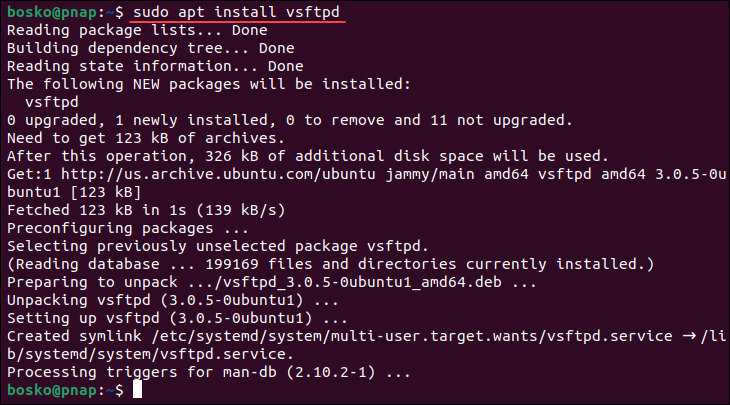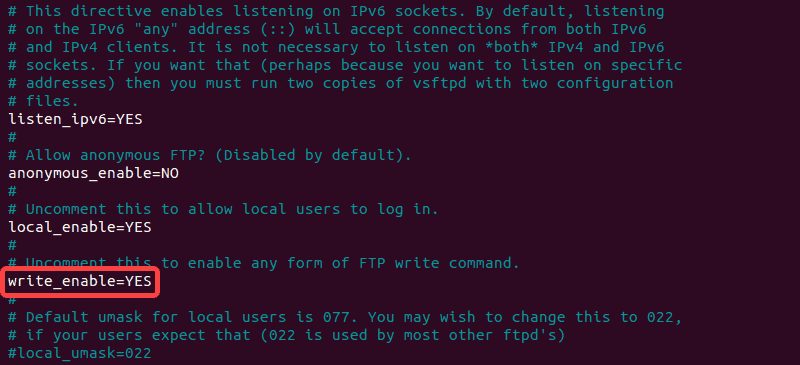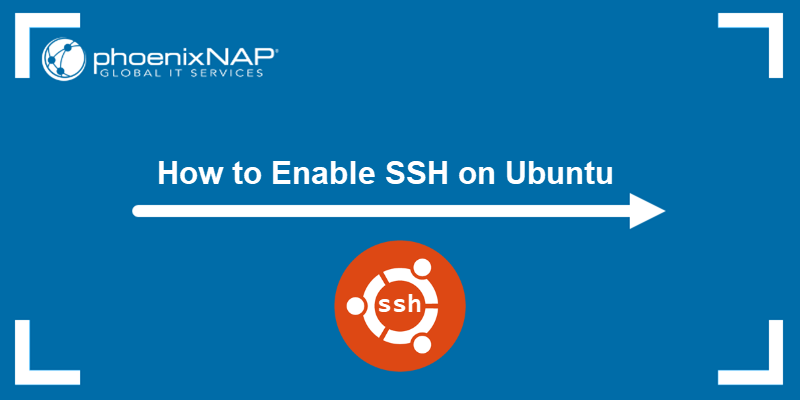FTP stands for File Transfer Protocol. It is similar to HTTP (HyperText Transfer Protocol) in that it specifies a language for transferring data over a network. FTP is unencrypted by default, so by itself, it is not a good choice for secure data transmission.
If you are looking to install an FTP server on Ubuntu, the simplest method is to use vsftpd.
This guide will help you install and configure an FTP server with vsftpd on Ubuntu.

Prerequisites
- Access to a user account with root privileges.
- Access to a terminal window/command line (Ctrl+Alt+T).
- The apt package manager, included by default.
Installing FTP Server on Ubuntu
Follow the steps outlined below to install the vsftpd utility on Ubuntu:
Step 1: Update System Package Repository
Start by updating the system package repository to ensure you get the latest program version. Open the terminal and run the following command:
sudo apt updateWait until the update process completes.
Step 2: Install vsftpd Server on Ubuntu
vsftpd is an open-source FTP utility commonly used in Ubuntu due to its simplicity. Install vsftpd by running the command below:
sudo apt install vsftpd
Step 3: Launch vsftpd
To launch the service and enable it to automatically start at boot, run the following commands:
sudo systemctl start vsftpd
sudo systemctl enable vsftpd
Note: Instructions for setting up and configuring FTP server with vsftpd are also available for CentOS 7 and Raspberry Pi.
Step 4: Backup Configuration Files
Before making any changes, back up your configuration files. Create a backup copy of the default configuration file using the cp command:
sudo cp /etc/vsftpd.conf /etc/vsftpd.conf_defaultThe command makes a copy of the vsftpd.conf file located in the /etc/ directory and saves it as vsftpd.conf_default in the same directory.
Step 5: Create FTP User
For this tutorial, we will create a dedicated FTP user. Skip this step if you intend to give FTP access to an existing user.
Use the syntax below to create a new user and set the password:
sudo useradd -m [username]
sudo passwd [username]Replace [username] with the user account name you want to create. After running the second command, the system prompts you to create a password for the new account. The example below illustrates the process of creating a ftpuser account and setting a password:

Step 6: Configure Firewall to Allow FTP Traffic
If you are using UFW, it is set to block FTP traffic by default. Run the following commands to open Ports 20 and 21 for FTP traffic:
sudo ufw allow 20/tcp
sudo ufw allow 21/tcp
Note: If you are using a different firewall, find the instructions to allow access on Port 20 and Port 21 for that specific firewall. Port 20 and 21 are the listening ports for the FTP service.
Step 7: Connect to the FTP Server
Connect to the FTP server using the following syntax:
sudo ftp [system_name]Replace [system_name] with the name of your system (taken from the command line).
For example:

After connecting to the server, log in using the account and password you have set up in Step 5 or with the account you intend to use for FTP.
Configuring vsftpd Server
Configuring the server is crucial as it allows you to customize settings to optimize performance, enable specific features, and tailor the server to meet your needs. Follow the sections below for some basic server configurations.
Change Default Directory
The FTP server uses the /srv/ftp directory as the default directory. You can create a new directory and set it as the FTP user home directory. Changing and restricting FTP to a specific directory improves overall server security.
Follow the steps below:
1. Use this syntax to create a new directory:
sudo mkdir /srv/ftp/[new_location]Replace [new_location] with the directory you want to create.
2. Use the following syntax to change the default directory where the ftp user will be placed upon login:
sudo usermod -d /srv/ftp/[new_location] ftp3. Restart the vsftpd service to apply the changes:
sudo systemctl restart vsftpd.serviceNow, you can put any files you want to share via FTP into the /srv/ftp directory (if you left it as the default) or the /srv/ftp/[new_location] directory (if you changed it).
Authenticate FTP Users
If you want to let authenticated users upload files, edit the vsftpd.conf file as shown in the steps below:
1. Open the vsftpd.conf configuration file in nano or another text editor:
sudo nano /etc/vsftpd.conf2. Find the entry labeled write_enable=YES and uncomment it (remove the # in front of the line):

3. Save and exit the file, and restart the FTP service by running:
sudo systemctl restart vsftpd.serviceConfiguring this setting allows the user to make changes inside their home directory.
Note: To learn more about using FTP, refer to our in-depth guide on Linux ftp command.
Securing FTP
Numerous exploits take advantage of unsecured FTP servers. There are several configuration options in vsftpd.conf that help secure your FTP server, thus preventing unauthorized access, potential data breaches, and system vulnerabilities.
Limit User Access
One method of securing vsftpd is to limit users to their home directory. Follow the steps below:
1. Open vsftpd.conf in a text editor:
sudo nano /etc/vsftpd.conf2. Uncomment the following line by removing the hash (#) sign:
chroot_local_user=YESThe following example shows the file in nano:

3. Save the file to apply the changes and exit the editor.
Create a User List File
The user list file enables vsftpd to deny or allow access to the listed users. The listed users will have full access to anywhere on the server. If a user is not listed, they are restricted to their specified home directory. Follow the steps below:
1. Open the /etc/vsftpd.chroot_list file in a text editor and add one user per line to create the list file.
2. Edit the vsftpd.conf file and uncomment (remove the #) the following lines:
chroot_local_user=YES
chroot_list_file=/etc/vsftpd.chroot_listThe following image illustrates the edits:

3. Restart the vsftpd service:
sudo systemctl restart vsftpd.serviceOn the other hand, the list of blocked users from FTP access is stored in the /etc/ftpusers file. To add blocked users, edit this file and add one user per line.
Encrypt Traffic with FTPS
Another method to secure your FTP server is to encrypt the traffic. This is done through FTPS - File Transfer Protocol over SSL (Secure Socket Layer).
For this to work, users need to be set up with a shell account on the FTP server. This adds a layer of secure encryption to your FTP traffic. Follow the steps below:
1. Create a new certificate with openssl. Run the command below:
sudo openssl req -x509 -nodes -days 365 -newkey rsa:2048 -keyout /etc/ssl/private/vsftpd.pem -out /etc/ssl/private/vsftpd.pemProvide the required information when prompted, or keep the default configuration by pressing Enter.
2. Open the vsftpd.conf file in an editor and change the line ssl_enable=NO to ssl_enable=YES.
Next, add the following lines to the configuration file:
rsa_cert_file=/etc/ssl/private/vsftpd.pem
rsa_private_key_file=/etc/ssl/private/vsftpd.pem
allow_anon_ssl=NO
force_local_data_ssl=YES
force_local_logins_ssl=YES
ssl_tlsv1=YES
ssl_sslv2=NO
ssl_sslv3=NO
require_ssl_reuse=NO
ssl_ciphers=HIGH
pasv_min_port=40000
pasv_max_port=50000Save the changes and exit the file.
3. Restart the service to apply the changes:
sudo systemctl restart vsftpd.serviceNote: For more information on SSL configurations and certificates, please see the Ubuntu FTP server documentation.
Conclusion
After following the steps in this tutorial, you should have installed an FTP server on Ubuntu with vsftpd, configured and secured it. An FTP server allows for efficient file sharing, transfer, and management across networks or the internet.
Next, learn the difference between SFTP and SSH or learn to use the Linux ftp command.



